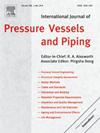海底管道腐蚀失效及内腐蚀危险区识别模型
IF 3
2区 工程技术
Q2 ENGINEERING, MECHANICAL
International Journal of Pressure Vessels and Piping
Pub Date : 2025-03-05
DOI:10.1016/j.ijpvp.2025.105498
引用次数: 0
摘要
海洋中蕴藏着丰富的油气资源,其平均储量远远超过陆地。但海底管道内部部件检测难度大,投资资金高,风险大。对L气田A4区块4条海底管道的内部部件进行检测后发现,G2管道腐蚀缺陷深度最大,占管壁厚度的36%。建立了考虑不同管道倾角、流速和Cl -浓度的管道内部腐蚀危险区识别模型。通过模拟回路实验和电化学手段,研究了不同温度、不同Cl−浓度和不同流速下不同倾角管道的腐蚀速率。基于Peng-Robinson (PR)方程和Pitzer模型,建立了非理想co2 -溶液体系的水化学模型。随后,结合流速系数和Cl−浓度系数,建立了海底管道内部CO2腐蚀风险区域识别模型。结合实验数据对该模型进行了验证,准确率超过80%。结合管道现场运行情况,确定海底管道易发生内腐蚀的区域,精确确定A4-G2管道内的高危区域和易穿孔部位。该研究对保障海底天然气输送管道的安全运行具有重要的理论和实践意义。本文章由计算机程序翻译,如有差异,请以英文原文为准。
Corrosion failure of subsea pipelines and identification model for internal corrosion risk zones
There are abundant oil and gas resources in the ocean, and its average reserves are far more than those on the land. However, it is difficult to detect the internal parts of submarine pipelines, with high investment capital and high risk. After detecting the internal parts of 4 submarine pipelines in Block A4 of L gas field, it was found that G2 pipeline had the largest corrosion defect depth, which accounted for 36 % of the pipe wall thickness. This study has established a model for identifying the internal corrosion risk areas of pipelines, which takes into account different pipeline inclination angles, flow rates and Cl− concentrations. Through the simulation loop experiment and by means of electrochemistry, the corrosion rates of pipelines with different inclination angles under different temperatures, Cl− concentrations and flow rates are studied. A hydrochemical model of the non-ideal CO2-solution system was constructed based on the Peng-Robinson (PR) equation and the Pitzer model. Subsequently, coefficients of flow rate and Cl− concentration are incorporated, leading to the establishment of a model for identifying the internal CO2 corrosion risk regions within submarine pipelines. This model is validated in conjunction with experimental data, achieving an accuracy rate surpassing 80 %. Additionally, by integrating the on-site operational conditions of the pipelines, the regions susceptible to internal corrosion in submarine pipelines are pinpointed, and the high-risk zones and the parts liable to perforation within the A4-G2 pipeline are precisely determined. This research holds significant theoretical and practical implications for safeguarding the safe operation of submarine natural gas transmission pipelines.
求助全文
通过发布文献求助,成功后即可免费获取论文全文。
去求助
来源期刊
CiteScore
5.30
自引率
13.30%
发文量
208
审稿时长
17 months
期刊介绍:
Pressure vessel engineering technology is of importance in many branches of industry. This journal publishes the latest research results and related information on all its associated aspects, with particular emphasis on the structural integrity assessment, maintenance and life extension of pressurised process engineering plants.
The anticipated coverage of the International Journal of Pressure Vessels and Piping ranges from simple mass-produced pressure vessels to large custom-built vessels and tanks. Pressure vessels technology is a developing field, and contributions on the following topics will therefore be welcome:
• Pressure vessel engineering
• Structural integrity assessment
• Design methods
• Codes and standards
• Fabrication and welding
• Materials properties requirements
• Inspection and quality management
• Maintenance and life extension
• Ageing and environmental effects
• Life management
Of particular importance are papers covering aspects of significant practical application which could lead to major improvements in economy, reliability and useful life. While most accepted papers represent the results of original applied research, critical reviews of topical interest by world-leading experts will also appear from time to time.
International Journal of Pressure Vessels and Piping is indispensable reading for engineering professionals involved in the energy, petrochemicals, process plant, transport, aerospace and related industries; for manufacturers of pressure vessels and ancillary equipment; and for academics pursuing research in these areas.

 求助内容:
求助内容: 应助结果提醒方式:
应助结果提醒方式:


